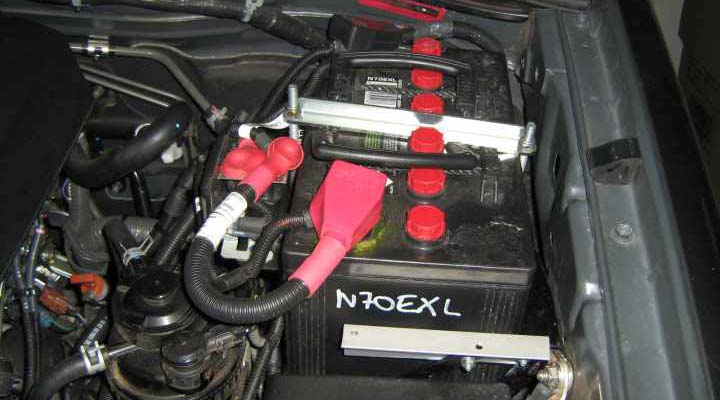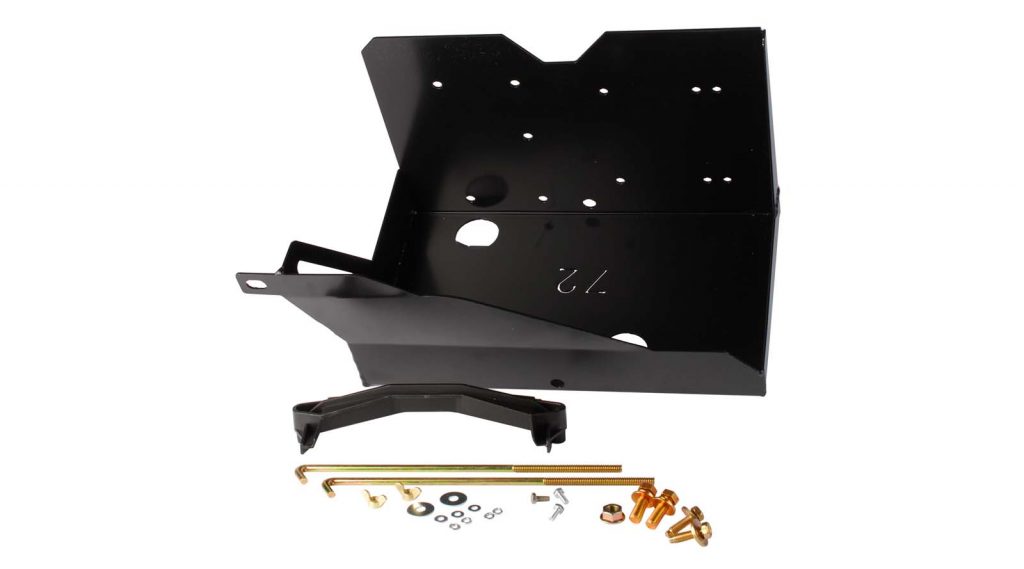Setting up a dual battery system In Your 4WD Vehicle

There are many tricks and traps when it comes to setting up a reliable auxiliary battery system in a Ute so I've put this article together to help guide you when setting up your system. There will be many that disagree with some of my advice here but let you make an informed decision that is based on real-world experience out there enjoying this marvellous country of ours.
Which Battery tray?
Well, that's pretty easy. Just grab one of the ones sold right here on VMN. We live and breathe Hilux around here and we only list products on our online store that pass our stringent quality guidelines.
We have used quite a bit of Outback Accessories gear over the years on our own Hilux and I have to say their gear has stood up to the test of time so that's why we sell their product.

Which Battery?
Well to start with you need an N70Z sized battery. What type depends on your individual needs. One thing that you can be sure, your battery will get a pretty hard life keeping your fridge cold. One type we don't recommend is the AGM deep cycle battery for a few reasons:
- They are simply too heavy to mount in a battery compartment regardless of the battery tray you choose. Early 2005 or so Hiluxes had a problem with cracked mudguards that was often traced back to fitment of an AGM battery. I believe that Toyota modified the design somewhere to toughen up the mudguard
- The environment in the engine bay is not good for them due to heat (which they don't like) and also vibrations which can cause premature failure.
We recommend you use a flooded wet cell cycle duty battery, something like a Delkor M27.
Which charging system/Isolator?
The most important feature any charging system must do is to isolate the cranking battery once the engine is turned off so it never gets run down while stationary and leave you stranded in the morning. The isolator does this by monitoring the input voltage and when the voltage falls below a specific voltage, it flicks a relay switch that isolates the cranking battery from your auxiliary electrical system.
When does the voltage fall below the threshold? Well, it is below that threshold when the engine is off and rises above that threshold when the engine is started AND the cranking battery is fully charged. At this point, the voltage rises as the alternator thinks it has done its job. This usually happens fairly quickly but can take a bit of time if the battery has been run down a bit.
So battery charging systems fall into 2 broad groups and in my view, many of them have been designed with overkill in mind to empty your wallet much more than is really necessary. Remember, when offroad, simple is good as it's easier to repair or find spare parts for. These are:
- Simple battery isolators such as our Matson battery Isolator that allow the maximum alternator current pass through to charge your dual battery system. The factory alternator outputs 70 amps but my aftermarket Bosch alternator outputs 100 amps.
- DC-DC chargers that do all sorts of smart stuff when charging your batteries but are limited to a fairly low charging current (eg the popular Redarc BCDC1220 only puts out 20 amps). Some even allow you to connect a solar panel to your charging system.
So ask yourself the question now. Why limit the ability of the charging system to charge your batteries? Why would I want to charge at 20 amps and drive say 5 hours to charge my batteries when I can get the job done with an isolator and a 100 amp alternator in just one hour's driving?
Well, the reason is that about the time the Hilux Vigo/N70 came on the market back in 2005, the car industry came under pressure to reduce energy consumption to meet emissions and fuel economy targets.
One trick they played was to get the ECU to reduce the alternator output voltage after a period of time from the 13.8 volts used for years down to 13.2 volts. 13.8 volts is a perfect charging voltage for lead-acid batteries but 13.2 volts is not so good.
However, using a flooded wet cell battery, you will still obtain acceptable performance if you use a more modern isolator that has a lower cut off voltage such as the Matson we sell.
So spurred on by the example of the amazing mains powered Ctek multi-stage battery chargers and some other wannabe brands, the technology was transferred to automotive applications and the DC-DC charger was born. Back in 2008 when I set up my Hilux, these did not even exist as I am sure if they did, ARB would have done their best to upsell me from the crappy Surepower isolator they stitched me up with.
In my view, the best system is the simplest and cheapest option and it works perfectly with my aftermarket alternator as it always seems to output 13.8 volts so an isolator works perfectly. I'm not sure if its the alternator or the auto sparky who fitted it for me that tricks the ECU into letting the alternator output 13.8 volts, but it works well for me.
Yeh, I know, you only have the standard Toyota Hilux alternator so it's going to reduce the voltage. Let me tell you about a really cool little trick that will let you charge your Toyota Hilux battery at 13.8 volts all day every day with a cheap as chips isolator and a cool little gadget that will only cost you $50 instead of $500 for a DC-DC charger.
Just head talk to us about an alternator voltage booster. This is a cleverly modified fuse that you pop into your fuse box on the alternator voltage sensing circuit that contains a diode.
Now a diode induces a voltage drop of 0.6 volts across it so the ECU now senses a voltage of 13.2 volts when the alternator is happily pumping out 13.8 volts. This is well below the design limits of the Toyota electrics so it does no damage to your vehicle at all.
However, after talking to engineers at Pirhana Offroad recently, they felt there was no need to go to this extreme for charging an auxiliary battery. and it was more useful if you were running a high current stereo system from a single battery and were not using a standard wet cell battery because you needed as much power you get from a small form factor battery.
If you drive a VW Amarok, you have no choice but to install a DC-DC charger. If you drive Ford Ranger, you can ask your dealer to change the ECU settings at your next service so it will support a standard battery isolator.
ADDENDUM: As time has gone on since this article was originally written, the ever increasing demand for efficiency in vehicles has seen more and more vehicles require the use of a DC-DC charger. We too finally finally weakened and installed one into our 2018 Toyota Hilux complete with a Solar input. So far we have been very pleased with this setup and when combined with a solar blanket, we have a good robust and reliable charging system.
Which DC-DC Charger to use?
There are many DCDC Chargers on the market. Our system of choice is the Australian Made Intervolt DCC Pro. We like this one becasue it has a Display module that can be fitted inside the vehicle so you can monitor your charging system and it has an Solar charging option. So this unit combined with a solar blanket ensures we always have the batteries fully charged even if we are not moving for the day.
One feature we liked when installing the Intervolt DCC Pro was its seperate inertial sense module that senses vibration on the vehicle which eliminates the need to wire it back to a switched ignition circuit. Very cool.
In fact we did a video of installing a DCC Pro to our own Hilux which you can watch below.
The mounting bracket for the Intervolt DCC Pro to suit the Toyota Hilux N80/Revo/Rocco/GUN that is shown as a prototype in the video is now also available from VMN. Now nicely powdercoated, this 2mm mild steel bracket won't crack or break like other stainless steel products are prone to so now we can offer a complete package and includes all of the hardware for a simple plug and play installation.
But won't my battery get overcharged if I just use an isolator?
No, not at all. A lead-acid battery will only ever accept the current it needs to become fully charged. You can add 47 different chargers to a battery system and the battery will just politely take what it needs and stop drinking up the current.
But I want to use a solar panel as well
Well, that's absolutely fine. Just use our Intervolt DCC Pro DC-DC charger as described earlier in this article.
But tow a caravan or camper trailer with solar panels on the roof
The in cab monitor included with the Intervolt DC Pro can monitor two DCC Pros so if your power consumption is heavy, we would recommend a second DCC Pro to be installed to service your caravan or camper trailer.
You can just hook your auxiliary batteries into your isolator controlled dual batteries via an Anderson plug and let your caravan charging system also charge your vehicle batteries.
Of course, if you plug your van into mains power, an Anderson plug extension lead is the perfect addition to keep your car battery fully charged and let you park in a more convenient location. You can't do this with a DC-DC charger as the DC-DC charger prevents the charge from going back to the vehicle so the so called experts will want to sting you for a DC-DC charger in your trailer as well.
So I had 2 Aux batteries in my Hilux and another 2 in my caravan and all of this worked perfectly driving down the road with 30 amps of solar on the van and 100 amps of alternator topping up 4 auxiliary batteries. I never needed to add the 3rd battery that there was provision for in the caravan.
But I have an absorption fridge in my van that draws 15 amps all the time
It might be unconventional but the best solution is to add a second isolator to your auxiliary battery system and direct connect it via a different colour anderson plug using heavy wire to your absorbtion fridge. I used a red Anderson plug for the fridge and a grey one to charge the batteries in the van.
Different colour anderson plugs are not interchangeable so you can never get them mixed up. So how does this work? Well, you start your car, the cranking battery gets charged and the first isolator starts to charge your car batteries.
After a while they are charged and the second isolator kicks in and starts to run your fridge. You will never have fridge problems again in your van. Well I never did anyway. The Matson isolator is ideal for this as its terminals are well protected to prevent any shorts occurring.
In conclusion
So if you follow the ideas I have outlaid in this article and correctly size the wires to your Aux batteries and camper trailer you will end up with a kick ass charging system and a few hundred dollars left in your pocket.
Hell, you might even plug a slow cooker into an inverter and cook dinner while driving down the road like one of my mates does! Believe me, this stuff works. Don't forget to buy your battery tray and Matson isolator from the VMN store.







